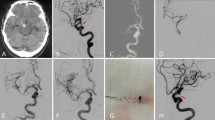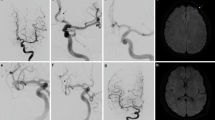Abstract
Purpose
Endovascular treatment (EVT) has become a major option in management of infectious intracranial aneurysms (IIAs) complicating infective endocarditis. We report a retrospective, single-center series of consecutive patients with IIAs treated by EVT.
Methods
Patients were included from January 2009 to July 2020. IIAs were diagnosed on DSA. Each patient underwent a neurological assessment before and after EVT and was followed up by imaging within 15 days of EVT. Safety was assessed on the evolution of NIHSS score. A minor stroke was defined as a worsening of NIHSS < 4 points. Efficacy was defined as the absence of hemorrhagic event during cardiac surgery and the exclusion of the IIA on control imaging.
Results
Sixty-two IIAs (30 ruptured) were diagnosed in 31 patients. Fifty-six IIAs were diagnosed on the first DSA and 6 on the early control exploration. EVT was achieved in 55 IIAs by parent artery occlusion with glue in 52 distal IIAs and coils in 3 proximal IIAs. IIAs were located in 90.9% of cases on a fourth-division branch of a cerebral artery. The neurological examination remained unchanged in 29 patients (93.5%), and 2 patients suffered minor stroke. EVT was performed before cardiac surgery in 20/22 patients. All treated IIAs were excluded on follow-up imaging. No hemorrhage was observed during cardiac surgery or in the aftermath. Seven (11.3%) unruptured IIAs were not embolized.
Conclusion
EVT of IIAs by occlusion of the parent artery is effective in preventing rupture and carries no significant neurological risk.


Similar content being viewed by others
Data availability
The data that support the findings of this study are available from the corresponding author upon reasonable request.
Code availability
Not applicable.
Abbreviations
- ACA:
-
Anterior cerebral artery
- EVT:
-
Endovascular treatment
- IIA:
-
Infectious intracranial aneurysm
- IQR:
-
Interquartile range
- SD:
-
Standard deviation
References
Ducruet AF, Hickman ZL, Zacharia BE et al (2010) Intracranial infectious aneurysms: a comprehensive review. Neurosurg Rev 33:37. https://doi.org/10.1007/s10143-009-0233-1
Kannoth S, Thomas SV (2009) Intracranial microbial aneurysm (infectious aneurysm): current options for diagnosis and management. Neurocrit Care 11:120–129. https://doi.org/10.1007/s12028-009-9208-x
Brust JCM, Dickinson PCT, Hughes JEO, Holtzman RNN (1990) The diagnosis and treatment of cerebral mycotic aneurysms. Ann Neurol 27:238–246. https://doi.org/10.1002/ana.410270305
Singla A, Fargen K, Blackburn S et al (2016) National treatment practices in the management of infectious intracranial aneurysms and infective endocarditis. J NeuroIntervent Surg 8:741–746. https://doi.org/10.1136/neurintsurg-2015-011834
Peters PJ, Harrison T, Lennox JL (2006) A dangerous dilemma: management of infectious intracranial aneurysms complicating endocarditis. Lancet Infect Dis 6:742–748. https://doi.org/10.1016/S1473-3099(06)70631-4
Ohtake M, Tateishi K, Ikegaya N et al (2017) Initial treatment strategy for intracranial mycotic aneurysms: 2 case reports and literature review. World Neurosurgery 106:1051.e9-1051.e16. https://doi.org/10.1016/j.wneu.2017.07.016
Petr O, Brinjikji W, Burrows AM et al (2016) Safety and efficacy of endovascular treatment for intracranial infectious aneurysms: a systematic review and meta-analysis. J Neuroradiol 43:309–316. https://doi.org/10.1016/j.neurad.2016.03.008
Esenkaya A, Duzgun F, Cinar C et al (2016) Endovascular treatment of intracranial infectious aneurysms. Neuroradiology 58:277–284. https://doi.org/10.1007/s00234-015-1633-2
Gross BA, Puri AS (2013) Endovascular treatment of infectious intracranial aneurysms. Neurosurg Rev 36:11–19. https://doi.org/10.1007/s10143-012-0414-1
Zanaty M, Chalouhi N, Starke RM et al (2013) Endovascular treatment of cerebral mycotic aneurysm: a review of the literature and single center experience. Biomed Res Int 2013:1–8. https://doi.org/10.1155/2013/151643
Nonaka S, Oishi H, Tsutsumi S et al (2016) Endovascular therapy for infectious intracranial aneurysm: a report of four cases. J Stroke Cerebrovasc Dis 25:e33–e37. https://doi.org/10.1016/j.jstrokecerebrovasdis.2015.11.033
Fusco MR, Stapleton CJ, Griessenauer CJ et al (2016) Endovascular treatment of intracranial infectious aneurysms in eloquent cortex with super-selective provocative testing: case series and literature review. Interv Neuroradiol 22:148–152. https://doi.org/10.1177/1591019915617326
Habib G, Lancellotti P, Antunes MJ et al (2015) 2015 ESC Guidelines for the management of infective endocarditis: the Task Force for the Management of Infective Endocarditis of the European Society of Cardiology (ESC)Endorsed by: European Association for Cardio-Thoracic Surgery (EACTS), the European Association of Nuclear Medicine (EANM). Eur Heart J 36:3075–3128. https://doi.org/10.1093/eurheartj/ehv319
Baddour LM, Wilson WR, Bayer AS et al (2015) Infective endocarditis in adults: diagnosis, antimicrobial therapy, and management of complications: a scientific statement for healthcare professionals from the American Heart Association. Circulation 132:1435–1486. https://doi.org/10.1161/CIR.0000000000000296
Fischer E (1938) Die Lageabweichungen der vorderen Hirnarterie im Gefäßbild. Zentralbl Neurochir 3:300–313
Krayenbühl HA, Yasargil MG, Huber P (1982) Cerebral angiography, 2nd edn. Thieme, Stuttgart, New York
Ragulojan R, Grupke S, Fraser JF (2019) Systematic review of endovascular, surgical, and conservative options for infectious intracranial aneurysms and cardiac considerations. J Stroke Cerebrovasc Dis 28:838–844. https://doi.org/10.1016/j.jstrokecerebrovasdis.2018.11.035
Goulenok T, Klein I, Mazighi M et al (2013) Infective endocarditis with symptomatic cerebral complications: contribution of cerebral magnetic resonance imaging. Cerebrovasc Dis 35:327–336. https://doi.org/10.1159/000348317
Fischer U, Arnold M, Nedeltchev K et al (2005) NIHSS score and arteriographic findings in acute ischemic stroke. Stroke 36:2121–2125. https://doi.org/10.1161/01.STR.0000182099.04994.fc
Koffie RM, Stapleton CJ, Torok CM et al (2015) Rapid growth of an infectious intracranial aneurysm with catastrophic intracranial hemorrhage. J Clin Neurosci 22:603–605. https://doi.org/10.1016/j.jocn.2014.09.007
Grandhi R, Zwagerman NT, Linares G et al (2014) Onyx embolization of infectious intracranial aneurysms. J NeuroIntervent Surg 6:353–356. https://doi.org/10.1136/neurintsurg-2013-010755
Jadhav AP, Pryor JC, Nogueira RG (2013) Onyx embolization for the endovascular treatment of infectious and traumatic aneurysms involving the cranial and cerebral vasculature. J NeuroIntervent Surg 5:562–565. https://doi.org/10.1136/neurintsurg-2012-010460
Chun JY, Halbach VV, Wilson CB (2001) Current multimodality management of infectious intracranial aneurysms. Neurosurgery 48:12
John S, Walsh KM, Hui FK et al (2016) Dynamic angiographic nature of cerebral mycotic aneurysms in patients with infective endocarditis. Stroke 47(1):e8–e10. https://doi.org/10.1161/STROKEAHA.115.011198
Rice CJ, Cho S-M, Marquardt RJ et al (2019) Clinical course of infectious intracranial aneurysm undergoing antibiotic treatment. J Neurol Sci 403:50–55. https://doi.org/10.1016/j.jns.2019.06.004
Corr P, Wright M, Handler LC (1995) Endocarditis-related cerebral aneurysms: radiologic changes with treatment. AJNR Am J Neuroradiol 16(4):745–748. https://pubmed-ncbi-nlm-nih-gov.ezproxy.u-paris.fr/7611032/
Bingham WF (1977) Treatment of mycotic intracranial aneurysms. J Neurosurg 46:428–437. https://doi.org/10.3171/jns.1977.46.4.0428
Park W, Ahn JS, Park JC et al (2017) Treatment strategy based on experience of treating intracranial infectious aneurysms. World Neurosurgery 97:351–359. https://doi.org/10.1016/j.wneu.2016.09.119
Kannoth S, Iyer R, Thomas SV et al (2007) Intracranial infectious aneurysm: presentation, management and outcome. J Neurol Sci 256:3–9. https://doi.org/10.1016/j.jns.2007.01.044
Martínez-Galdámez M, Biondi A, Kalousek V et al (2019) Periprocedural safety and technical outcomes of the new Silk Vista Baby flow diverter for the treatment of intracranial aneurysms: results from a multicenter experience. J NeuroIntervent Surg 11:723–727. https://doi.org/10.1136/neurintsurg-2019-014770
Edjlali M, Guédon A, Ben Hassen W et al (2018) Circumferential thick enhancement at vessel wall MRI has high specificity for intracranial aneurysm instability. Radiology 289:181–187. https://doi.org/10.1148/radiol.2018172879
Boukobza M, Naggara O, Duval X, Laissy J-P (2020) Acute enlargement, morphological changes, and rupture of intracranial infectious aneurysm in infective endocarditis. Serial imaging. J Clin Neurosci 82:237–240. https://doi.org/10.1016/j.jocn.2020.11.001
Author information
Authors and Affiliations
Contributions
Conception and design: FS, AG, and EH. Acquisition of data: FS, AG, and EH. Analysis and interpretation of data: FS, AG, and EH. Drafting the article: FS, AG, and EH. Critical revision of the article: JPSM, MAL, VC, and ME. Review of submitted version of manuscript: FS, AG, JPSM, MAL, VS, ME, and EH. Approval of the final version of the manuscript on behalf of all authors: AG.
Corresponding author
Ethics declarations
Conflict of interest
On behalf of all authors, the corresponding author states that there is no conflict of interest.
Ethics approval
The manuscript has been approved by the institutional review board without patient informed consent required and has been performed in accordance with the ethical standards laid down in the 1964 Declaration of Helsinki and its later amendments and national laws (CNIL N° 2221622).
Consent to participate
Informed consent was obtained from all individual participants included in the study.
Consent for publication
Not applicable.
Additional information
Publisher's note
Springer Nature remains neutral with regard to jurisdictional claims in published maps and institutional affiliations.
Supplementary Information
Below is the link to the electronic supplementary material.
Rights and permissions
About this article
Cite this article
Serrano, F., Guédon, A., Saint-Maurice, JP. et al. Endovascular treatment of infectious intracranial aneurysms complicating infective endocarditis: a series of 31 patients with 55 aneurysms. Neuroradiology 64, 353–360 (2022). https://doi.org/10.1007/s00234-021-02798-5
Received:
Accepted:
Published:
Issue Date:
DOI: https://doi.org/10.1007/s00234-021-02798-5




